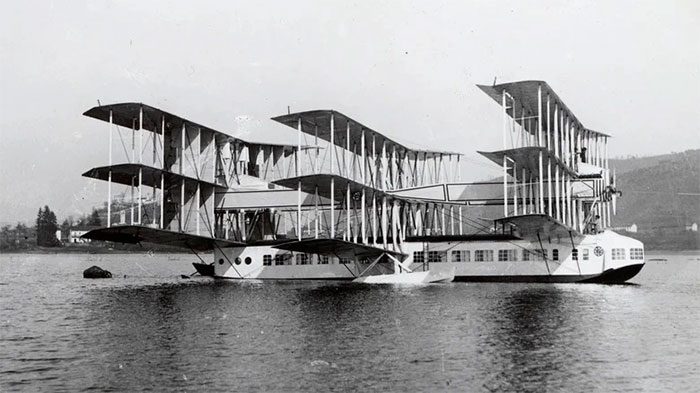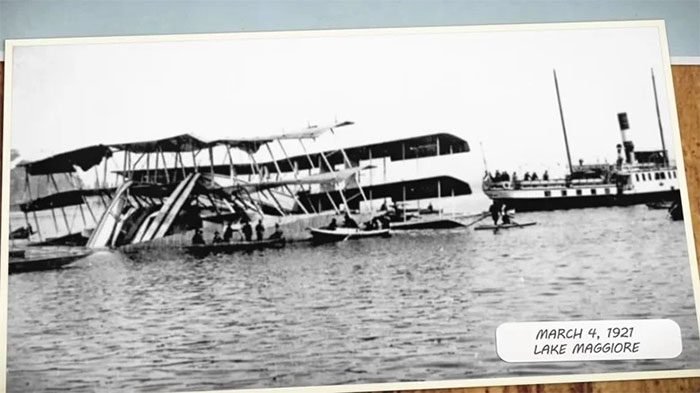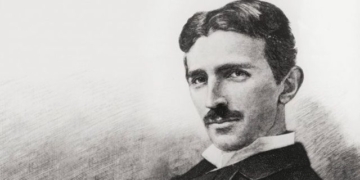On October 5, 1905, the Wright brothers successfully piloted the Flyer III around the state of North Carolina in the United States for 39 minutes. They covered nearly 40 kilometers during this historic flight, and could have flown even further if their vehicle hadn’t run out of fuel. Six years later, on November 1, 1911, the first bomb was dropped from a German-built monoplane onto Libya during the war between Italy and Turkey.
Meanwhile, in Italy, Giovanni Battista Caproni—a great admirer of the Wright brothers—built his first aircraft and quickly established an aircraft manufacturing company called Società Italiana Caproni in 1908. He was such a skilled aircraft manufacturer that by the time World War I began in August 1914, he had designed about 30 other aircraft and rapidly became Italy’s leading aircraft supplier.
In the early 1920s, aircraft manufacturing technology and the scientific knowledge behind flights were still in their infancy. Commercial flights could only be made over short distances, and transatlantic transportation primarily relied on ships, often taking up to five days to complete.
However, Caproni had accumulated a wealth of experience in aircraft manufacturing by then. He was determined to change the long sea voyages into a thing of the past. This inventor aimed to create a gigantic seaplane capable of carrying up to 100 passengers at once.

Caproni Ca.60 Transaereo Seaplane.
A “Flying Bus” with Wooden Seats
At that time, as one of the world’s leading aircraft manufacturers, Caproni combined everything known to be able to fly and scaled up the design significantly. A colossal flying monster was born, named Caproni Ca.60 Transaereo, also known as Noviplano—a name meaning 9 wings based on its overall design.
It is not hard to imagine that this aircraft had 9 wings, arranged in three sets of three wings each. Essentially, Caproni took three triplanes and bound them together with 250 meters of struts and over 2.4 kilometers of cables. Underneath was a long fuselage resembling a passenger bus, where people would sit on long wooden benches.
When completed, the aircraft had a wingspan of 30 meters, a height of 9 meters, and weighed over 15 tons. It was so large and heavy that it required stabilizing floats to take off from the water. Operating and controlling this giant aircraft required 8 crew members, with the captain and co-pilot seated in an outdoor cockpit at the front of the aircraft. Meanwhile, additional flight engineers would sit in one of two cockpits located at the front and rear wings.
The vehicle used 8 Liberty L-12 V12 engines, each capable of producing 400 horsepower. It was said to have a maximum speed of 140 km/h, a cruising speed of 110 km/h, and a range of 600 km.

The giant aircraft collapses.
When Theory Doesn’t Match Practice
However, the problem with this aircraft at that time was its short flight range, which made refueling require landing in the middle of the ocean and the resupply process would amount to dozens of times. Thus, the flight time for transatlantic journeys would be considerably extended, not to mention potential issues that could arise. This fundamentally quickly negated the nature of flying with this vehicle from the start.
This led to a million-dollar question: could it fly?
According to reports, its first test flight took place in March or April 1921 at Lake Maggiore, Switzerland. After reaching speeds of nearly 80 km/h, it briefly lifted its fuselage out of the water. In the second test flight, it did manage to get airborne, reaching a speed of 100 km/h but then crashed straight down into the water, destroying the entire aircraft.
However, another report indicated that an unexpected test flight occurred on March 4, 1921. Designer Caproni wasn’t even present at the lake when pilot Federico Semprini, who had previously tested the aircraft a month earlier, unexpectedly took off. The reasons for his takeoff remain undisclosed to this day, but the flight resulted in the complete destruction of the aircraft.
Researchers believe that sooner or later, this aircraft would have failed due to a serious problem. An aircraft cannot have three sets of wings aligned because each additional set of wings hinders the overall lift capability. Without lift, an aircraft cannot fly reliably and safely. Furthermore, the struts and cables used to hold the components together created significant drag. Ultimately, the aircraft was poorly designed due to the aviation techniques not being fully understood at that time.


















































